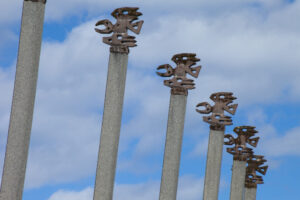You may have heard of them, maybe even seen them from time to time in your travels around UBC. But how much do you really know about the outdoor works of art that have been enriching campus environments for over seven decades?
Since the late 1940s, curated works of art have been prominently featured at various points throughout the university. These artworks “…give voice to multiple stories about the history of UBC and Vancouver and are part of an ever-evolving narrative about art, space and place, and our own sense of narrative.” ** The outdoor collection has grown significantly over the years and now boasts an impressive collection of 24 works from the University Art Collection.
One of the best ways to gain a deeper understanding of these works and appreciate how much they contribute to enriching the community for residents and visitors alike is to take in the UBC Outdoor Art Tour. This self-guided tour starts at the Belkin Art Gallery and expands outwards to various points around the UBC campus. Depending on your level of interest – and commitment – you can spend as little as one hour or upwards of three hours for the complete tour. (Guided tours are also available by appointment through the Gallery.)
With the warmer weather now upon us, what better time to set aside an hour (or two) to explore the many works of art that make up UBC? Start your tour off right by picking up some ice cream from Rain Or Shine then finish off with a celebratory stop at one of the local University Boulevard restaurant patios like Brown’s Crafthouse or Kinton Ramen’s.
Below are a few of the works of art that you will discover on the Artwalk tour. Their locations along with a complete listing of all works, the artists and a tour map can be found in a downloadable PDF.
Classical Toy Boat – Glenn Lewis
(1987)

Photo: Michael R. Barrick (BG3552)
Location: Pool on the north side of the University Centre (formerly the Faculty Club)
Made from Italian Carrera marble, the shape of the boat reflects the innocence of a child’s toy while the material is a direct reference to classical Roman sculpture. The position of the boat appears to defy gravity while also calling out a spirit of resilience.
The Lion & St. Mark
(1957)

Photo: Howard Ursuliak (BG778)
Location: Exterior south wall of St. Mark’s Theological College
Crafted in bronze, this piece depicts St. Mark, author of the second Gospel in the New Testament. He holds a quill pen in one hand and a scroll in the other and is looking to the sun for inspiration, said to symbolize the light of Christ. The lion is connected to the opening of the Gospel itself, which tells the story of St. John the Baptist.
Did You Know? This welded sculpture is set off from the wall and is designed to reflect the afternoon sun, casting shadows on the white wall of the building that add depth and dimension to the work.
Man About To Plant Alfalfa – George Norris
(1967)

Photo: BG3915
Location: Courtyard of the H. R. MacMillan Building which houses the Faculty of Land & Food Systems
Long-time Dean of the Faculty of Agriculture, Blythe Alfred Eagles, commissioned the granite work from Norris as a memorial to his parents (pioneers in the settlement of BC) as well as to all of those who laboured to improve agriculture in the province.
Reconciliation Pole – James Hart
(2015-1017)

Photo: Hover Collective / UBC Brand & Marketing
Location: Facing north on Main Mall between Agronomy Road and Thunderbird Boulevard
This 800-year-old red cedar pole was shipped from the Island of Haida Gwaii and carved under the direction of James Hart with help from members of the Haida Nation. Through traditional Haida symbols and contemporary imagery, the work recognizes the complex history of Canada’s Indian Residential Schools.
Three Forms – Robert Clothier
(1956)

Photo: Howard Ursuliak (BG158)
Location: Belkin Art Gallery
Three concrete forms, each resembling a slightly square C, are stacked and turned to show a configuration that changes according to the angle from which it is viewed. Considered an abstract work, the combination of geometric shapes also suggests the shape of the human body.
Did You Know? Robert Clothier trained as an actor in London and was well known for playing the role of “Relic” in “The Beachcombers”, a prime-time series that ran on CBC television from 1972 to 1990.
Thunderbirds – Zeljko Kujundzic
(1967)

Photo: Michael R. Barrick (BG 425)
Location: Atop the supporting poles of Thunderbird Stadium
Twelve giant birds – perched and appearing ready to take flight – greet teams and visitors to Thunderbird Stadium, home of the UBC Thunderbirds. Made from concrete, these works were commissioned for the stadium’s opening in 1967. Seen as a sacred creature by Indigenous people of the Northwest Coast, the thunderbird is a powerful spirit bird whose wings caused thunder and eyes flashed lightning.
Tuning Fork – Gerhard Class
(1968)

Photo: Howard Ursuliak (BG154)
Location: In front of the main entrance to the Music Building.
Class created the work for UBC’s fine arts area, where students study music, fine art, theatre and architecture. The sculpture is made from Corten steel, with the two free-standing forms complementing one another while evoking the close relationship between the arts disciplines.
Untitled – Paul Deggan
(1965)

Photo: Howard Ursuliak (BG190)
Location: Exterior of north wall of Neville Scarfe Building entrance
As unique as it is thought-provoking, Deggan’s work is comprised of three separate components made from three different materials: copper, brass and aluminum. As the materials have aged, they have continued to change colour, further adding to their appeal and allure. It’s interesting to note that while this work is an abstract piece, Deggan was inspired by nature, which is easily seen in the leaf patterns and tree bark textures.
** Source: “Outdoor Art Tour”, PDF, Morris & Helen Belkin Art Gallery (https://belkin.ubc.ca/collections/#outdoor)


